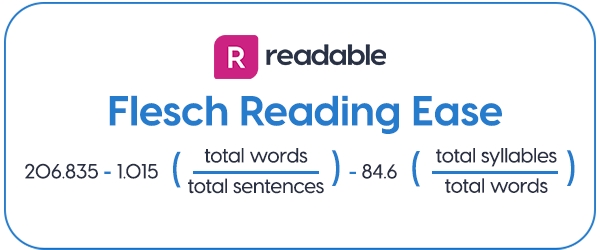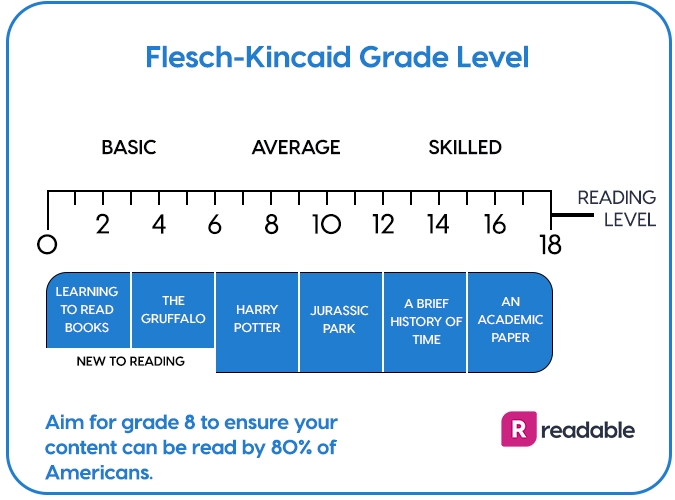Writing at Grade level - Readability score
'Readable' text is what we all want. What we sometimes produce, is difficult to read and technical. Writing to you audience level is one measure, writing to your grade level is another.
What is a Flesch Reading Ease score?
The Flesch Reading Ease gives a text a score between 1 and 100, with 100 being the highest readability score. Scoring between 70 to 80 is equivalent to school grade level 8. This means text should be fairly easy for the average adult to read.
The formula was developed in the 1940s by Rudolf Flesch. He was a consultant with the Associated Press, developing methods for improving the readability of newspapers.
Now, over 70 years later, the Flesch Reading Ease is used by marketers, research communicators and policy writers, amongst many others. All use it to help them assess the ease by which a piece of text will be understood and engaged with.
What is the Flesch-Kincaid Grade Level?
The Flesch Kincaid Grade Level is a widely used readability formula which assesses the approximate reading grade level of a text.
It was developed by the US Navy for their technical manuals used in training.
Now it’s used for a much wider variety of applications. If a text has a Flesch Kincaid level of 8, this means the reader needs a grade 8 level of reading or above to understand it. Even if they’re an advanced reader, it means the content is less time-consuming to read.
How do Flesch tests work?
Flesch readability tests work by taking into account sentence and word counts. The mathematical formula underlying the two tests look like this:

At first glance, the formulas for the readability scores may not seem to make sense. But, the building bricks that make up both Flesch scores are straightforward and based on two factors:
Sentence length. As judged by the average number of words in a sentence
Word length. As judged by the average number of syllables in a word
Sentences that contain a lot of words are more difficult to follow than shorter sentences.
Many of the classics of English Literature were written in the 18th and 19th centuries. During this time, the average sentence was a lot longer than it is now.
You could have a long paragraph which was one long sentence; strings of clauses connected with peppered semicolons were the norm. However, because the average length of a sentence has decreased with time, so has our attention span. We no longer have the tolerance for lengthy, meandering prose.
Similarly, words that contain a lot of syllables are harder to read than words that use fewer syllables. For example, “it was a lackadaisical attempt” is more difficult to read than “it was a lazy attempt”.
What do the Flesch scores mean?
Both Flesch scores reflect how readable a piece of content is. The Flesch Reading Ease score is between 1 and 100, and the Flesch Kincaid Grade Level reflects the US education system. They are both calculated with the same units, but the weightings for these units are different between the two tests, resulting in different readability scores.
Flesch-Kincaid Reading Ease
The higher the reading score, the easier a piece of text is to read.
Note that this differs from the majority of readability scores where a lower score is easier.
For example, a reading score of 60 to 70 is equivalent to a grade level of 8-9 so a text with this score should be understood by 13 to 15-year-olds.
To make sense of a Reading Ease score, a conversion table is needed. This translates the score into a grade level.
Flesch-Kincaid Grade Level
The Flesch-Kincaid Grade Level is equivalent to the US grade level of education. It shows the required education to be able to understand a text.

Text intended for readership by the general public should aim for a grade level of around 8, schooling age 13 to 14.
When is Flesch-Kincaid most useful?
Flesch Kincaid is ideal for helping you balance your writing styles and levels of sophistication because readability scores can give you valuable insights into how easy your text is to understand. This has a direct impact on the extent people engage with and take on your message.
How do the Flesch tests compare to other readability formulas?
The Flesch tests are the most well-established in use cases ranging from marketing to government.
Whereas some formulas are more specialist, Flesch Kincaid comes the most recommended for all sectors and disciplines.
Last updated
Was this helpful?
